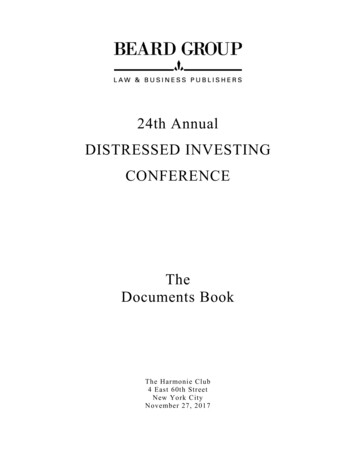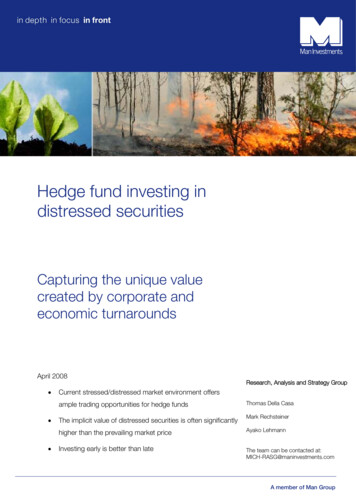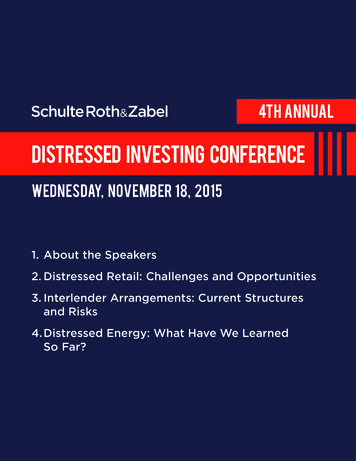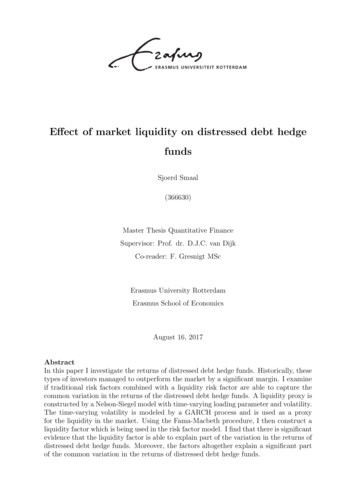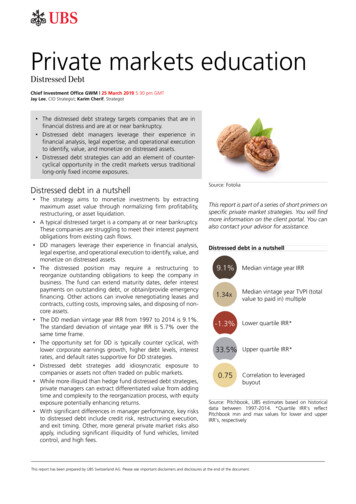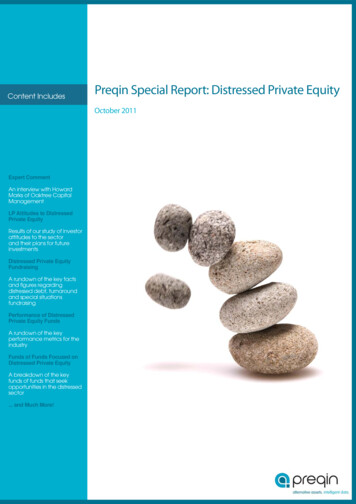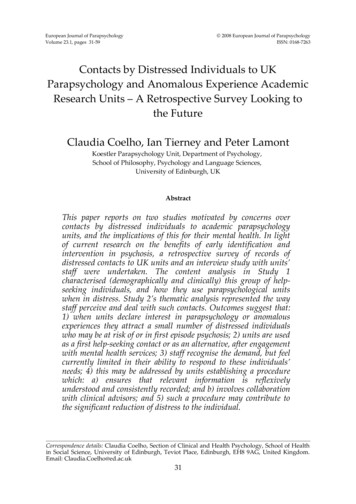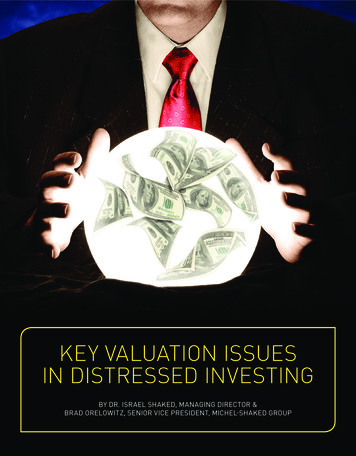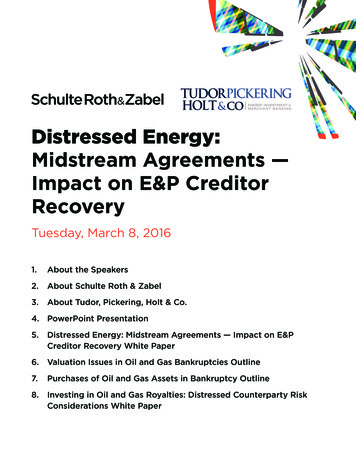
Transcription
Distressed Energy:Midstream Agreements —Impact on E&P CreditorRecoveryTuesday, March 8, 20161.About the Speakers2.About Schulte Roth & Zabel3.About Tudor, Pickering, Holt & Co.4. PowerPoint Presentation5.Distressed Energy: Midstream Agreements — Impact on E&PCreditor Recovery White Paper6.Valuation Issues in Oil and Gas Bankruptcies Outline7.Purchases of Oil and Gas Assets in Bankruptcy Outline8.Investing in Oil and Gas Royalties: Distressed Counterparty RiskConsiderations White Paper
About the Speakers
Aaron S. BlomquistHead of Infrastructure, Managing Director, Investment BankingTudor, Pickering, Holt & Co.ablomquist@TPHco.com 1 713.333.7183Aaron is a Managing Director in Investment Banking, covering midstream and MLPs. He waspreviously a director with the Global Energy & Power Group at Bank of America Merrill Lynch,where he focused primarily on midstream and MLP clients. Prior to Bank of America Merrill Lynch,he was a vice president at Evercore Partners. Aaron holds a B.S. in finance from Louisiana StateUniversity, where he received the University Medal and graduated summa cum laude. He is a CFAcharterholder.Selected Transactional ExperienceM&A Advisory¡¡ Pioneer Natural Resources on the sale of its interest in EFS Midstream to EnterpriseProducts¡¡ Morgan Stanley Infrastructure on its sale of Southern Star Central Corp. to GE EnergyFinancial Services & Caisse de dépôt et placement du Québec¡¡ Crestwood Midstream Partners on its merger with Crestwood Equity Partners¡¡ El Paso Pipeline Partners on its merger with Kinder Morgan Inc.¡¡ Regency Energy Partners on its acquisition of PVR Partners¡¡ Devon Energy Corporation on the combination of its midstream business with CrosstexEnergy Inc. and Crosstex Energy LP¡¡ Kinder Morgan Inc. on its dropdown of 50 percent of EPNG and 50 percent of El PasoMidstream to Kinder Morgan Energy Partners¡¡ Phillips 66 on its sale of the Riverhead Terminal to United Refining¡¡ Howard Energy Partners on its acquisition of Meritage Midstream Services¡¡ MarkWest Hydocarbons Inc. in its sale to MarkWest Energy Partners LP¡¡ Targa Resources Inc. on its acquisition of Dynegy Midstream LP¡¡ GE Commercial Finance Energy Financial Services on the sale of its 40-percent LLCinterest in CrossCountry Energy LLC to a consortium of investorsMidstream MLP IPOs¡¡ PennTex Midstream Partners¡¡ Phillips 66 Partners LP¡¡ Summit Midstream Partners LP¡¡ Susser Petroleum Partners LP¡¡ American Midstream Partners LP¡¡ Tesoro Logistics LP¡¡ Targa Resources Corp.¡¡ Targa Resources Partners LP¡¡ Universal Compression Partners LP (re-named Exterran Partners LP)¡¡ Buckeye GP Holdings LPDistressed Energy: Midstream Agreements — Impact on E&P Creditor Recovery
John ChapmanVice President, Investment BankingTudor, Pickering, Holt & Co.jchapman@TPHco.com 1 713.333.3890John serves as a Vice President in Investment Banking, covering midstream and MLPs, in additionto Restructuring Advisory. He was previously an associate at Miller Buckfire in New York. Johnholds a B.A. in religion from Princeton University.Selected Transactional Experience¡¡ Advised GSO and co-investors on restructuring and sale of Chesapeake ClevelandTonkawa to FourPoint Energy¡¡ Advised on dropdowns to SunCoke Energy Partners (fairness opinions)¡¡ Advised on equity financing of Pro Oilfield Services¡¡ Advised lenders on restructuring of Greenfield Energy Services¡¡ Advised lenders on restructuring of Platinum Energy Solutions¡¡ Advised on sale of Alaska Electric Light & Power to Avista Corp.¡¡ Advised Oncor Electric Delivery in Energy Future Holdings restructuring¡¡ Advised lenders on restructuring of Orchard Brands¡¡ Advised on restructuring of American Capital Ltd.¡¡ Advised on restructuring of European Capital Ltd.¡¡ Advised PropCo lenders on restructuring of Station Casinos¡¡ Advised on restructuring of Magnachip Semiconductor¡¡ Advised on restructuring of Calpine Corp.Distressed Energy: Midstream Agreements — Impact on E&P Creditor Recovery
Lawrence V. GelberPartnerSchulte Roth & Zabel 1 212.756.2460 lawrence.gelber@srz.comLarry practices in the areas of distressed mergers & acquisitions, debtor-in-possession financing,corporate restructuring, creditors’ rights and prime brokerage insolvency/counterparty risk. Larry’sextensive experience in Chapter 11 reorganization cases includes his representation of debtors,secured and unsecured creditors, lenders, investors and acquirers. His debtor representationshave included Quigley Company Inc., NTL Inc., Safety-Kleen Corp., Fansteel Inc. and CAI WirelessSystems Inc. Among his lender and creditor representations are Ableco Finance LLC, CerberusBusiness Finance LLC and Wells Fargo Capital Finance. Investor and acquirer representationsinclude Mount Kellett Capital Management LP, Petra Capital Management LP, Cerberus CapitalManagement LP and Prentice Capital Management LP.In recognition of his professional excellence and his contributions to the fields of restructuring andinsolvency, Larry was inducted as a fellow in the 25th Class of the American Bankruptcy College.He has also been recognized by The Legal 500 United States as a leader in his field. Larry isan active member of the American Bankruptcy Institute, the American Bar Association’s Section ofBusiness Law, the New York City Bar Association and the Turnaround Management Association. Heis a regular contributor to The Bankruptcy Strategist, Bankruptcy Law360 and Norton BankruptcyLaw Adviser and has spoken at conferences sponsored by the Practising Law Institute, AmericanBankruptcy Institute, the William J. O’Neill Great Lakes Regional Bankruptcy Institute and otherorganizations. Some of his recent presentation topics have covered challenges and opportunities indistressed retail, distressed acquisitions in Chapter 11 and pension plan liabilities.Larry received his J.D., cum laude, from New York University School of Law and his B.A., magnacum laude, from Tufts University.Distressed Energy: Midstream Agreements — Impact on E&P Creditor Recovery
Adam C. HarrisPartnerSchulte Roth & Zabel 1 212.756.2253 adam.harris@srz.comAdam is a partner in the New York office, where he is chair of the Business Reorganization Groupand a member of the firm’s Executive Committee. His practice includes corporate restructurings,workouts and creditors’ rights litigation, with a particular focus on the representation of investmentfunds and financial institutions in distressed situations. Adam has represented a variety of clientsin connection with distressed acquisitions by third-party investors or existing creditors through“credit bid” or similar strategies, as well as in court-supervised and out-of-court restructurings. Inaddition to representing creditors and acquirers in distressed situations, Adam has representedChapter 11 debtors, as well as portfolio companies in out-of-court exchange offers, debtrepurchases and other capital restructurings. His recent representations include advising an adhoc committee of holders of 6.50-percent notes issued by Seventy Seven Energy Inc., CerberusCapital Management LP in connection with the Chapter 11 bankruptcy of RadioShack Corp., MountKellett Master Fund II in the Chapter 11 case of The Great Atlantic and Pacific Tea Company (asboth lender and equity holder), and a group of private equity funds in the Allied Systems Holdingsbankruptcy, in their capacity as first lien lenders, in a successful challenge to the efforts of a privateequity sponsor that tried to acquire a controlling interest in the first lien debt.Numerous ranking publications, including The Best Lawyers in America, Chambers Global,Chambers USA, The K&A Restructuring Register and The Legal 500 United States, have recognizedAdam as a leader in his field. He has co-authored publications addressing cramdown plans,redemption option value, priming DIPs, out-of-court restructurings and proposals to reformChapter 11. He also contributed to Distressed Investing M&A (SRZ in association with Mergermarketand Debtwire), and he co-authored “Health Care Business Restructuring for Secured Lenders,” anSRZ guide republished by Bloomberg BNA – Bankruptcy Law Reporter. Adam also co-authors the“Out-of-Court Restructurings, the Bankruptcy Context, and Creditors’ Committees” chapter in PLI’sInsider Trading Law and Compliance Answer Book. He presents frequently on topics of concern tothe private funds community, including, most recently, interlender arrangements, structuring creditfunds, distressed investing in the health care sector, fraudulent conveyance laws and distressedprivate equity investments.Adam earned his J.D., magna cum laude, from Georgetown University Law Center and his B.A. fromEmory University.Distressed Energy: Midstream Agreements — Impact on E&P Creditor Recovery
David J. KarpPartnerSchulte Roth & Zabel 1 212.756.2175 (New York) 44 (0) 20 7081 8048 (London)david.karp@srz.comDavid leads SRZ’s Distressed Debt & Claims Trading Group, providing advice in connection withU.S., European and emerging market debt and claims trading matters, with a focus on specialsituations, corporate restructuring, and distressed mergers and acquisitions. David frequentlyrepresents hedge funds and private equity funds in connection with investments in distressed andnon-performing assets and NPL portfolios across a wide range of industries and in jurisdictionsaround the globe. He also advises investment funds in connection with oil and gas royalty tradingand distressed energy credit investments. His recent energy representations include investors inWalter Energy Inc., Samson Resources, Energy and Exploration Partners Inc., Sabine Oil & GasCorporation, Stallion Oilfield Services Ltd., Seahawk Drilling Inc., ATP Oil & Gas Corporation andTrident Resources Corporation.David is recognized as a leading lawyer by New York Super Lawyers, and by the founder of ReorgResearch as “undoubtedly one of the best in the field at what he does best: making sure fundsand their investments are protected when transacting and executing trades in distressed debt andclaims.” He is an active member of the National Association of Royalty Owners and a frequentauthor for The Hedge Fund Law Report, Bloomberg, The Bankruptcy Strategist and CorporateRescue and Insolvency. His recent publications include “Structuring Winning Bids: European NPLPortfolio Transactions” and “Investing in Oil and Gas Royalties: Distressed Counterparty RiskConsiderations.”David earned his J.D. from Fordham University School of Law and his B.S. from Cornell University.Distressed Energy: Midstream Agreements — Impact on E&P Creditor Recovery
About Schulte Roth & Zabel
SRZ's Distressed Investing GroupAs the premier brand in investment management in the world’s two major financial markets — New York and London —Schulte Roth & Zabel is recognized as a key player in both the mature U.S. distressed investment market and the stilldeveloping European distressed investment market. We have the experience and expertise to provide clients withcomprehensive representation and advice in all manners of large and complex distressed situations across a wide rangeof industries and opportunities.With market-leading capabilities on both sides of the Atlantic, our Distressed Investing Group provides business-savvysolutions by strategically blending expertise from our business reorganization, finance, investment management, mergers& acquisitions, real estate, tax and other practice areas. Our superior knowledge of the investment management industryand experience developing and implementing the structures and products that a distressed investor analyzes results insubstantial synergies and gives us an insider’s edge. Well-known for our distressed investing work, we advise on, andhave extensive experience with, out-of-court transactions, navigating bankruptcies (including bankruptcy acquisitions,debt restructurings, loan-to-own strategies and debtor-in-possession and exit financings), distressed real estate, capitalstructure analysis and trading issues.Structuring or restructuring a deal may also require collaboration by our clients with one or more other parties who havealigned interests in order to achieve their investment objectives. We regularly advise consortiums and syndicates in jointinvestments, whether those investments are structured as club deals or the group acts together as an informal, ad hoccommittee, or otherwise. We are experienced in defining, negotiating and navigating those working relationships andmanaging the complex governance and tax issues that arise.Select Energy Restructuring RepresentationsAd Hoc Committeeof UnsecuredBondholdersFirst Lien Lenders/DIP LendersFirst Lien LendersCreditorCreditorCreditorCreditors’ CommitteeAd Hoc Committeeof d LenderCreditorSecured LenderSecured LenderCreditorSecond Lien LenderCreditorCreditorSecured LenderCreditorPen Holdings, Inc.andElk Horn Coal Co.Potential BidderActivist InvestorCreditor
About Tudor, Pickering, Holt & Co.
Tudor, Pickering, Holt & Co. OverviewThe firm’s mission is to be the premier integrated energy investment and merchant bankingfirm, providing the highest quality advice and professional services to our institutional andcorporate partners.¡¡ 170 employees exclusively focused on energy¡¡ Diversified lines of business designed to provide extensive industryEnergy Focusedand advisory expertise: Investment Banking, Securities, Acquisitions& Divestitures, Private Equity, Asset Management¡¡ Headquartered in Houston with offices in New York, Denver, Londonand CalgaryResearch, Sales &Trading¡¡ Equity research covering 160 energy companies¡¡ Sales and trading exclusively covering energy¡¡ Institutional investor focus¡¡ Integrated sector efforts in Upstream, Midstream/MLP, Downstream,Oilfield Services and Power¡¡ M&A: strategic advisory, sell-side, buy-side, special committeeassignments, fairness opinions and restructuringInvestment Banking¡¡ Capital markets: IPO, follow-on equity & debt offerings, privateequity, private placements¡¡ Dedicated Acquisitions & Divestitures practice¡¡ Liability management, recapitalization and restructuring advisory¡¡ Extensive technical knowledge of oil & gas¡¡ Over 1.5 Bn of assets under management¡¡ TPH Partners: private equity fund with seven active energyAsset Managementinvestments¡¡ TPH Asset Management: group of long-only and hedge fundsfocused on energy securities¡¡ Co-Investment: energy private equity co-investment strategy
PowerPoint Presentation
E&P / MidstreamInterdependencyNotes:Distressed Energy: Midstream Agreements — Impact on E&P Creditor Recovery
Gathering, Processing andTransportationNotes:Distressed Energy: Midstream Agreements — Impact on E&P Creditor Recovery
Dedications &Minimum VolumeCommitmentsNotes:Distressed Energy: Midstream Agreements — Impact on E&P Creditor Recovery
Contract RejectionWhat’s at Stake?Notes:Distressed Energy: Midstream Agreements — Impact on E&P Creditor Recovery
Traditional Midstream ViewNothing to See HereNotes:Distressed Energy: Midstream Agreements — Impact on E&P Creditor Recovery
Traditional Midstream ViewCovenants Runningwith the LandNotes:Distressed Energy: Midstream Agreements — Impact on E&P Creditor Recovery
Traditional ViewCollides with StateLaw RealityNotes:Distressed Energy: Midstream Agreements — Impact on E&P Creditor Recovery
Covenants Running with the Land Privity of estate Touching and concerning the land Relates to a thing in existence or specificallybinding the parties and their assigns Intended by the original parties to run with theland The successor to the burden has noticeNotes:Distressed Energy: Midstream Agreements — Impact on E&P Creditor Recovery
Surface Estate vs. Mineral EstateNotes:Distressed Energy: Midstream Agreements — Impact on E&P Creditor Recovery
Privity of EstateNotes:Distressed Energy: Midstream Agreements — Impact on E&P Creditor Recovery
Production Dedicationvs. Mineral EstateDedicationNotes:Distressed Energy: Midstream Agreements — Impact on E&P Creditor Recovery
Mineral Estate “Sticks” in the Bundle of Rights–––––Right toRight toRight toRight toRight todevelopleasereceive bonus paymentsreceive delay rentalsreceive royalty paymentsNotes:Distressed Energy: Midstream Agreements — Impact on E&P Creditor Recovery
SabineNotes:Distressed Energy: Midstream Agreements — Impact on E&P Creditor Recovery
Quicksilver ResourcesImpact onAsset SalesNotes:Distressed Energy: Midstream Agreements — Impact on E&P Creditor Recovery
Distressed Energy: MidstreamAgreements — Impact on E&P CreditorRecovery White Paper
Distressed Energy: Midstream Agreements — Impact onE&P Creditor RecoveryExploration and production (“E&P”) companies typically enter into wellhead service contracts (collectively,1“Midstream Contracts”) for gathering, processing and transporting oil and gas to market. In exchange for theseservices and the capital commitment to build a gathering system, the E&P may provide the midstream counterparty(“Midstream Service Provider”) with a dedication of reserves or acreage commitment for performance of theMidstream Contracts. (See Figure 1). A dedication of reserves is intended to assure an adequate utilization of thegathering and pipeline system and is often accompanied by a hydrocarbon purchase contract between the E&P andthe Midstream Service Provider. In many cases, Midstream Contracts also include a commitment of a minimumvolume of oil or gas (“Minimum Volume Commitment” or “MVC”) that is produced and processed from the land onwhich the E&P operates, which requires the E&P to pay a fixed fee to the Midstream Service Provider if volumerequirements are not met.Creditors of and potential investors in both the E&P and the Midstream Service Provider should analyze the preciselanguage and mechanics in the relevant party's Midstream Contracts because the provisions relating to dedicationand MVCs will be significant in determining: (1) whether or not the Midstream Contract can be rejected, and (2) howthe Midstream Contract claim will be treated in an E&P bankruptcy case. While case law addressing the treatment ofmidstream agreements is unclear and incomplete, and the outcome in each case is fact-specific and dependent onthe law of the state where it is heard, recent bankruptcy case developments (e.g., In re Sabine Oil & Gas Corporation2and In re Quicksilver Resources) provide some measure of guidance for creditors and investors. Ultimately, the legalanalysis of whether a Midstream Contract can be rejected must be incorporated into an economic analysis of thesecontracts and the alternatives available to the E&P and Midstream Service Provider.Figure 11“Gathering” refers to “the process of collecting gas at the point of production (the wellhead) and moving it to a collection point for furthermovement through a pipeline’s principal transmission system.” Patrick H. Martin & Bruce M. Kramer, Williams & Meyers Manual of Oil and GasTerms 433 (15th ed. 2012).2In the Sabine bankruptcy case, the issues have been fully briefed by the debtors and the midstream gatherer counterparties respectively, andthe presiding judge has heard oral arguments and indicated on the record that a bench decision is forthcoming. In the Quicksilver bankruptcycase, the debtors have filed a motion to reject executory contracts with certain midstream counterparties (Dkt. 1128). We are monitoring bothcases and are happy to respond to any inquiries with respect to either case or the issues set forth in this White Paper. The Sabine andQuicksilver bankruptcy cases are currently pending under the captions In re Sabine Oil & Gas Corporation, et al. (Case No. 15-11835) (Bankr.S.D.N.Y.) and In re Quicksilver Resources Inc., et al. (Case No. 15-10585) (Bankr. D. Del.), respectively.
What’s at Stake?Midstream Providers have argued that midstream contracts with acreage dedications and language identifying suchinterests as “covenants that run with the land” are not property of the E&P’s bankruptcy estate and not capable ofbeing rejected as an executory contract. If Midstream Providers are correct, they would have significant leverage inrenegotiating the terms of services with E&Ps, and the resulting decrease in the size of asset pool available for theE&P’s creditors could lead to substantially diminished recoveries. In response, E&Ps and their creditors have arguedthat dedications merely create for a service provider a contractual interest that may be rejected in bankruptcy,resulting in a prepetition general unsecured claim for the damages flowing from rejection.The dedication language and mechanics of a Midstream Contract can be granular and esoteric, but they requirecareful analysis given their potential implications in a bankruptcy case. To illustrate, based on Texas law — where oilor gas in the ground is real property, but once separated from the earth, becomes personal property — a provisionthat purports to dedicate an interest in the E&P’s oil or gas “in place” (i.e., in the ground) would seem to create acovenant running with the land, whereas one dedicating an interest in its oil or gas “as and when produced” (i.e., at3the surface or wellhead) may be read by a court to create a mere contractual interest. (See Figure 2).To determine whether or not Midstream Contracts are executory agreements that can be rejected, a bankruptcycourt will likely consider numerous factors, including: (1) the parties’ expressed intent to create (or not create) aconveyance of a real property interest or covenant that runs with the land; (2) the point at which such interest isdeemed fully vested; (3) real property filings recorded or agreed to be recorded; (4) holder(s) of title to production;(5) rights to control and risk for losses; (6) definition of the dedicated interests (i.e., minerals in place, production orboth); (7) the E&P’s right to sell or transfer minerals and leases with or without binding successors and assigns; and(8) the existence of MVCs.Figure 23Under Texas law, once minerals are produced, they cease to be real property and instead become personalty. See, e.g., Sabine Production Co.v. Frost Nat. Bank San Antonio, 596 S.W.2d 271, 276 (Tex. App. 1980) (“Once minerals have been severed from the reservoir or strata whereinthey were originally contained, such minerals become personalty.”); Colorado Interstate Gas Co. v. Hunt Energy Corp., 47 S.W.3d 1, 10 (Tex.App. 2000) (“Once oil or gas has been severed from the ground, it becomes personalty.”); Riley v. Riley, 972 S.W.2d 149, 155 (Tex. App. 1998)(citing Phillips Petroleum Co. v. Adams, 513 F.2d 355, 363 (5th Cir. 1975) (under Texas law, “[o]il and gas are realty when in place and personaltywhen severed from the land by production”).Distressed Energy: Midstream Agreements — Impact on E&P Creditor Recovery 2
Priority of Dedication and Minimum Volume CommitmentSecured creditors to E&Ps historically may have given little thought to the possibility of competing claims byMidstream Providers, because it was generally accepted by market participants that any such claims would be juniorto the secured creditors’ claims in the E&P’s bankruptcy case. Recently, however, some Midstream Providers haveargued that even though no transfer of any interest in the debtor’s mineral estate took place, the dedications in theirMidstream Contracts are actually real property interests or covenants running with the land that are not subject tothe preexisting liens or claims of any of the debtor’s other creditors and should receive payment — in amountscalculated based on any MVC and remaining contract term — prior to any cash flowing into the creditor waterfall, orbe afforded an elevated payment priority in the E&P’s bankruptcy.Midstream Contract Rejection and Treatment of ClaimsA distressed E&P may determine that its Midstream Contracts render development of its assets uneconomical,especially where such a contract includes an MVC that is not being satisfied or is too expensive. Under Section 365 of4the Bankruptcy Code, an E&P debtor has the ability to “reject” executory contracts. Rejection means that the E&Pdebtor may, with the bankruptcy court’s approval, choose to stop performing under the contract, leaving the5counterparty with a prepetition unsecured damages claim that will be paid pro rata with other unsecured creditors.A covenant running with the land, however, is treated as attached to the underlying real property, and therefore, maynot be capable of being rejected. A dedication that is deemed to be a covenant running with the land could thusdilute other creditors’ recoveries, potentially including those of senior secured claims, by siphoning value from themineral estate. The case law regarding interpretation of dedication provisions — whether as real property interests, acovenant that runs within the land, some type of “senior interest” or mere contractual rights — is unsettled, and somededications may not fit neatly into a single category. Even if it appears in the express terms of the document and realproperty records indicate that an interest in the mineral estate or leases has been conveyed by dedication, it may bethat a dedication is not one of the state law-recognized ways of transferring such an interest and, accordingly, that6no such interest has, in actuality, been transferred.The inclusion of MVCs may make a Midstream Contract more prone to rejection if the E&P is unable to satisfy theMVC, thereby forcing the E&P to pay additional fees when it is not meeting the minimum volume. MVCs also may beviewed as inconsistent with a real property interest or covenants running with the land, as the credit support theyprovide may be viewed as less consistent with transfers of the risks associated with ownership and more consistentwith an unsecured borrowing.SabineMidstream Contract rejection is being litigated in the Sabine bankruptcy case. In Sabine, the debtors filed a motion toreject two gathering agreements. The counterparties (the “Gatherer Counterparties”) opposed rejection on the basisthat their contracts contained covenants that ran with the land and were not capable of being rejected. The GathererCounterparties relied heavily on the U.S. Court of Appeals for the Fifth Circuit’s decision in In re Energytec Inc., 739F.3d 215, 221 (5th Cir. 2013), which held that certain interests securing fees owed to an affiliate of the seller of a gaspipeline were covenants running with the land and therefore could not be rejected. One critical difference, however,is that the Energytec court considered an encumbrance on production passing through a gathering system and thegathering system itself after the wellhead; the facts in Sabine (and the issue with many other Midstream Contracts)7concern a possible covenant running with the land before the wellhead and as part of the mineral estate interest.4The “Countryman” definition of an executory contract, which has been accepted by most courts, is “a contract under which the obligation ofboth the bankrupt and the other party to the contract are so far unperformed that the failure of either to complete performance wouldconstitute a material breach excusing the performance of the other.” Depending on the language and mechanics of a Midstream Contract, it maybe considered “executory” under the Countryman definition — thereby subjecting it to rejection under Section 365. Prof. Vern Countryman,Executory Contracts in Bankruptcy: Part I, 57 Minn. L. Rev. 439, 458-62 (1973).5See 11 U.S.C. § 365; N.L.R.B. v. Bildisco & Bildisco, 465 U.S. 513, 531 (1984) (“Damages on the contract that result from the rejection of anexecutory contract must be administered through bankruptcy and receive the priority provided general unsecured creditors.”).6Texas courts determining whether a mineral estate (or any right therein) has been conveyed consistently require the grant of an interest in themineral estate. See French v. Chevron, 871 S.W.2d 276 (Tex. App. 1994).7Further, the beneficiary of the covenant running with the land in the Energytec case benefited from a security interest and lien on the pipelinesystem that generated the fee subject to the covenant running with the land. This security interest influenced the court as the recovery may bethe same, or similar, whether a claim is based on a covenant running with the land or is a secured claim. The court noted, “Newco’s interests,including a transportation fee, security interest and rights to consent to assignments, are covenants running with the land.”Distressed Energy: Midstream Agreements — Impact on E&P Creditor Recovery 3
This distinction and whether the dedication covers “production” or an interest in the mineral estate (i.e., leases and oiland gas in the ground) is critical.The Sabine litigation is currently ongoing, but the issues raised by the debtors and the Gatherer Counterpartiesdiscussed below are instructive. While no decision has yet been rendered, after hearing oral arguments on thespecific contracts subject to rejection, the bankruptcy court judge advised the parties that she is “inclined” to rulethat the dedications at issue in Sabine are not covenants running with the land and that the contracts could thereforebe rejected.Breakdown of ClaimsTiming and use of the gathering system also impact a Midstream Provider’s potential claim against an E&P debtor. AMidstream Contract claim may arise from activity or damages that accrued: (1) from utilization of the GatheringSystem before the Chapter 11 petition was filed, which gives rise to a prepetition unsecured claim; (2) in connectionwith rejection of a contract, for the remaining term of the contract and MVC fees (e.g., from an E&P debtor’s rejectionof a Midstream Contract, which gives rise to a prepetition damages claim); or (3) from an E&P debtor’s post-petitionutilization of the Midstrea
Well-known for our distressed investing work, we advise on, and have extensive experience with, out-of-court transactions, navigating bankruptcies (including bankruptcy acquisitions, debt restructurings, loan-to-own strategies and debtor-in-possession and exit financings), distressed re
